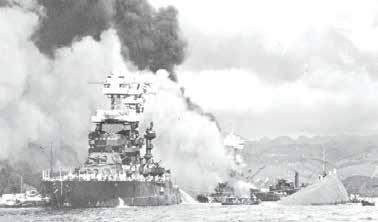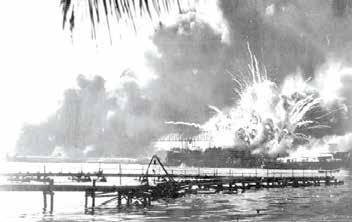
5 minute read
Heroic Jews at the Attack of Pearl Harbor by Avi Heiligman
Forgotten Her es Heroic Jews at the Attack of Pearl Harbor
By Avi Heiligman
Louis Schleifer Lt. Stephen Saltzman Ensign Nathan Asher
For more than two years, the United States was a neutral country watching while World War II raged on in Europe and other parts of the world. Japan was afraid that the United States would interfere in its plans to dominate parts of Asia and the islands in the Pacific. In what they saw as a preventative measure, the Japanese attacked the American fleet based at Pearl Harbor, Hawaii, on the morning of December 7, 1941. Other American bases in the Philippines, Guam, and Wake Island were attacked as well, causing considerable damage.
Out of the clear blue sky over Pearl Harbor came a large formation of planes that were bearing down upon the American fleet moored at Battleship Row. Four battleships were sunk (two later were repaired and returned to service), many more ships were damaged, hundreds of aircraft were damaged or destroyed, and more than 2,300 Americans were killed in the attacks. However, the Japanese did not attack the valuable aircraft carriers, as they were out to sea. In the coming months and years, slowly but surely, it was the carriers that became the focal point of American task forces that caused the tide of war to turn in the Americans favor.
There were many Jewish sailors, airmen, and soldiers present during the surprise attack on Pearl Harbor. Here are some of their stories.
Louis Schleifer was attached to the 4th Reconnaissance Squadron stationed killed. The Newark, New Jersey, native was awarded the Silver Star posthumously for his actions. (A few months later, during a memorial service for Schleifer, Senator Charles McNary of Oregon said, “Jews have been fighting oppression and tyranny for centuries. They received their
at Hickam Field when he saw Japanese planes dropping bombs on the airfield. The private grabbed his helmet and revolver and started towards planes that had been parked in the middle of the field. As he attempted to move them to the relative safety of a hangar, he saw Japanese planes shooting at other soldiers. Schleifer began shooting his gun at the strafing planes but was shot and basic training in Egypt and became seasoned soldiers on the battlegrounds of Europe,” said McNary. “Wherever tyranny threatens, wherever the rights of man are in danger of being destroyed, there you will find the Jew, joining forces with others willing to fight and die for freedom.”)
As the attacks began, many ships attempted to make their way out of the harbor and into open water. The crew on the destroyer USS Blue (DD-387) watched as the battleship USS Utah was torpedoed at 8 AM, and she began to fire back at the attacking planes with machine gun fire and later with guns from her main battery. With only four officers on board, it fell to Ensign Nathan Asher to make the decision to move out of the harbor and away from the main attacks. Asher was a recent Jewish Naval Academy graduate from Philadelphia and was the senior officer present on the Blue as the other three officers were reservists. The commanding and executive officers were on shore for the weekend, and the commanding officer had given instructions that under no circumstances was the ship to get underway without him or the executive officer. As the Japanese began their attack, Asher felt that in order to save the ship from damage he needed to move the ship away from the harbor. By defying his commanding officer’s orders, he was credited with preventing the Blue from being damaged. The Blue kept on firing at the attacking planes as she went through the channel entrance and shot down a Jap-

anese fighter. Under Asher’s directions, the destroyer carried out depth charge attacks on submarines that were sighted in the area. Asher wrote in his after-action report: “One submarine either sunk or severely damaged by depth charging in approximate location 4 miles, bearing 190° true, from Diamond Head Light.” In 1960, a Japanese midget submarine was found sunk with signs of a depth charge attack in that area. Asher received a commendation from Secretary of the Navy Frank Knox for his actions on the “day that will live in infamy.”
Many of the soldiers, sailors, and airmen fought back at the Japanese planes as the attack progressed. Jewish Lieutenant Stephan Saltzman of Wilmington, Delaware, who was with the 98th Coastal Artillery, ran outside his post at Schofield Barracks armed with an automatic rifle. Along with Sergeant Lowell Klatt, they waited until a pair of Japanese fighters came within a hundred yards of their exposed position. Saltzman then shot several times at one of the planes and hit the pilot, causing the plane to crash. His regional commander said it was the first Japanese plane brought down at Pearl Harbor and one of the 29 planes that did not return to the Japanese carriers. Later, Saltzman joined the Air Corps as a fighter pilot and flew 22 missions over Europe. He was injured on one of the missions and flew back to his base in England with one hand. Saltzman received the Silver Star for his actions at Pearl Harbor and the Distinguished Flying Cross for his mission over France.
December 7, 1941, will always be remembered as one of the bleakest days in American history even as the country commemorates 81 years this week since the attack. There were many unsung heroes that fought back at Pearl Harbor, and it is history that will not be forgotten.
Avi Heiligman is a weekly contributor to The Jewish Home. He welcomes your comments and suggestions for future columns and can be reached at aviheiligman@gmail.com.












